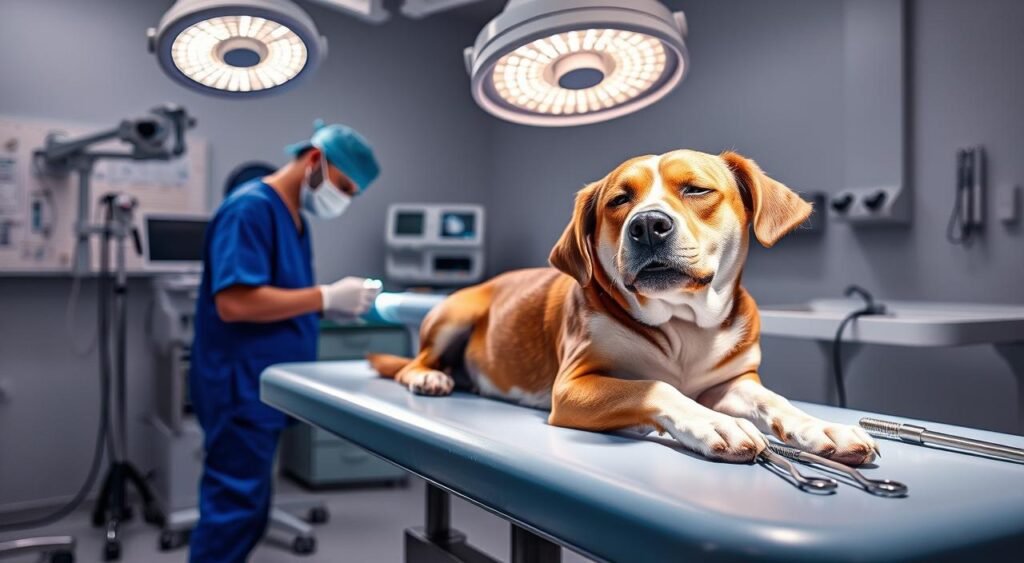Ever wondered why your dog’s breath might not be the freshest? It could be because of their teeth. Dog teeth removal is a common issue many pet owners face. But, not many know much about it.
Since four out of five dogs get periodontal disease by age four, understanding canine dental health is key. It’s important to know about dog teeth removal.
Pet dental surgery can seem scary, but it’s often needed for your dog’s health. It might be due to decay, injury, or chronic conditions. Dog tooth extraction could help your pet feel better.
Many dogs seem happier after their teeth are removed. This shows they were in pain for a long time.
Learning about dog teeth removal can make you feel better. From the first diagnosis to aftercare, each step is crucial. Healing usually takes about two weeks after surgery.
Most dogs can go back to their usual diet in a week or two. As we explore this topic, you’ll learn why regular dental check-ups are important. You’ll also know how to spot dental problems and what to expect if your dog needs a tooth extraction. Let’s make sure your dog’s smile stays healthy and bright!
Dog Dental Health and Tooth Extractions
Dog dental health is key to your pet’s happiness and health. Dogs, like humans, can get dental problems that might mean losing teeth. It’s important to know why dogs get teeth pulled and why regular dental checks are a must.
Common Reasons for Dog Tooth Extractions
Dogs get teeth pulled for many reasons. Bad oral care leads to decay and gum disease, which are big reasons. Teeth that break or don’t fall out on their own, and tumors in the mouth are also common causes. Sometimes, teeth need to be pulled because of how they grow.
| Extraction Reason | Percentage |
|---|---|
| Decay/Gum Disease | 60% |
| Fractured Teeth | 20% |
| Persistent Baby Teeth | 10% |
| Oral Tumors | 5% |
| Orthodontic Issues | 5% |
The Importance of Regular Dental Check-ups
Regular dental visits are crucial for your dog’s health. These visits help vets catch dental problems early. They check for plaque, tartar, and gum disease.
When Extraction is Necessary vs. Other Treatment Options
Tooth extraction is needed when a tooth can’t be saved. For less severe cases, vets might suggest other treatments. These could be dental cleaning, antibiotics, or minor surgery. The aim is to keep your dog’s teeth healthy and pain-free.
The Dog Teeth Removal Procedure
Getting ready for dog dental surgery is key to a smooth tooth extraction. Your vet will walk you through it. This includes a full physical check-up and blood tests. These steps help pick the right anesthesia for your dog.
Preparing for Dental Surgery
You’ll need to keep your dog from eating for 12-24 hours before the surgery. This step lowers the chance of problems during anesthesia. Your vet might also give antibiotics to stop infection.

Anesthesia and Safety Measures
Using the right anesthesia is crucial for a painless tooth removal. Your vet will watch your dog’s vital signs closely during the surgery. The anesthesia type and amount depend on your dog’s age, health, and needs.
The Tooth Extraction Process
The tooth removal process has several steps:
- Dental x-rays to check tooth roots and bone
- Careful loosening of the tooth from its socket
- Gentle removal of the tooth, making sure all roots are out
- Cleaning and stitching the extraction site if needed
Recovery from dog dental surgery is usually fast. Many pets can go home the same day. Your vet will give you specific care instructions. This includes feeding soft food and avoiding rough play for about two weeks after surgery.
| Reason for Extraction | Frequency |
|---|---|
| Tooth decay/gum disease | Common |
| Broken teeth | Occasional |
| Retained baby teeth | Less common |
| Oral tumors | Rare |
| Orthodontic issues | Uncommon |
Post-Operative Care and Recovery
After your dog’s tooth extraction, it’s important to follow the right care steps. Your vet will give you specific instructions. Here are some general tips for caring for your dog’s teeth after surgery.
For the first few days, feed your dog soft food. Canned food or cooked chicken and rice are good options. Avoid hard treats for two weeks to protect the surgical area. Also, keep your dog calm and quiet for 1-2 days as they may still feel the effects of anesthesia.
Watch the extraction site for any signs of infection or problems. Some swelling is okay, but too much bleeding or pus means you should call your vet. If your dog had stitches, they are usually absorbable and will fall out in about 30 days.
- Give any medicines your vet prescribed
- Don’t brush your dog’s teeth for two weeks
- Give lots of love and comfort to help them feel better
- Use an E-collar if your vet says it’s needed to keep the area clean
You’ll likely have a follow-up visit 7-10 days after surgery to check on your dog’s healing. Remember, every dog recovers differently. Keep in touch with your vet during this time.
| Recovery Timeline | Activities | Feeding |
|---|---|---|
| Days 1-2 | Limited activity, rest | Soft food only |
| Days 3-7 | Gradual increase in activity | Soft food, avoid hard treats |
| Days 8-14 | Normal activity resuming | Transition to regular diet |
| After 2 weeks | Full activity | Normal diet, dental care resumes |
Potential Complications and When to Seek Help
After your dog’s tooth extraction, it’s important to watch their recovery closely. Most dogs heal quickly, but problems can happen. Knowing the signs of trouble helps keep your pet safe.
Common Post-Extraction Symptoms
Most dogs don’t face big issues after tooth extraction. They might feel a bit sore. You’ll see some swelling, a bit of bleeding, and they might act tired.
They might also want to eat softer foods for a few days. This is normal.
Warning Signs of Complications
Watch out for these signs that could mean trouble:
- Bad breath or an odd smell from their mouth
- Swelling in the jaw or under the eyes
- Too much drooling or not wanting to eat
- Runny nose or being really tired for more than 2-3 days
Emergency Situations Requiring Immediate Attention
Some signs need you to act fast. Call your vet right away if you see:
- Heavy bleeding that won’t stop
- Signs of infection like fever or pus
- Having trouble breathing or being very tired
- Not eating or drinking for over 24 hours
Most dogs get better in two weeks. If you’re worried, call your vet. They can tell if your pet needs help right away or if it’s just healing.
Conclusion
Dog dental care is key to your pet’s health. To avoid tooth extractions, start with good oral hygiene. Brushing, professional cleanings, and dental checks keep your dog’s teeth healthy.
Over 80% of dogs get gum disease by age three. This shows how vital early prevention and dental care are. Small breeds and seniors face more dental problems, making care even more crucial for them.
While tooth extractions might be needed, many dental issues can be prevented. By focusing on your dog’s dental health, you protect their teeth and overall well-being. Watch for dental signs and talk to your vet to keep your dog’s smile bright.
FAQ – Dog Tooth Extractions
What are the common reasons for dog tooth extractions?
Dogs often need tooth extractions for broken teeth, severe tooth decay, or to stop infections. These infections could spread to other parts of the mouth or body.
Why are regular dental check-ups important for dogs?
Regular dental check-ups help keep a dog’s mouth healthy. Vets can spot problems like plaque, tartar, bad breath, and loose teeth early. This helps prevent more serious issues.
How is a dog prepared for dental surgery and tooth extraction?
Preparing a dog for dental surgery includes a physical exam and bloodwork. This helps choose the right sedation. The dog must fast for 12-24 hours before surgery.
What safety measures are taken during a dog’s tooth extraction procedure?
Anesthesia is used to keep the dog safe during the procedure. The vet considers the dog’s age and health. This ensures the dog’s safety throughout the surgery.
What does post-operative care involve after a dog’s tooth extraction?
After surgery, the dog needs to be watched for pain and any complications. They should eat soft food and not exercise too much. Pain meds might be given, and follow-up visits are needed 7-10 days later.
What are the common post-extraction symptoms in dogs, and when should I be concerned?
Dogs might have mild swelling, pain, and some bleeding after tooth extraction. But, if they have a lot of pain, swelling, bleeding, or can’t eat, it’s a sign of trouble. They should see a vet.
What are some emergency situations that require immediate veterinary attention after a dog’s tooth extraction?
If a dog’s stitches get ripped, shows signs of infection, or won’t eat or drink, it’s an emergency. Get them to the vet right away.








